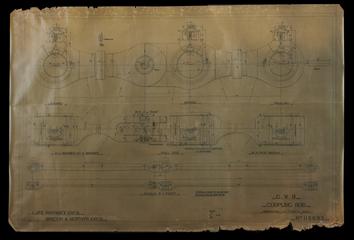
British Rail: Western Region
Railways in Britain were nationalised under the terms of the Transport Act 1947 which came into effect on 1 January 1948. The Act created the British Transport Commission and the Railway Executive. The Act vested the business and assets of the then existing railway companies in the British Transport Commission. The Railway Executive, a corporate body subordinate to the British Transport Commission, was created to manage and operate the railways. It divided them into six geographical regions, largely based on the areas served by the pre-nationalisation railway companies, one of which was Western Region.
It comprised the railway operations in England and Wales of the former Great Western Railway Company with adjustments to eliminate “penetrating lines”. From the former London Midland and Scottish Railway Western Region gained the lines in central and south Wales, the Birmingham-Bristol-Bath line, the Somerset and Dorset Joint line (in part) and from the Southern Railway the lines west of Exeter. It also was assigned Marylebone to Northolt. Sections of the former Great Western Railway lines to Weymouth, the Midland & South West Junction, the Didcot Newbury & Southampton, and Reading – Basingstoke and Westbury – Salisbury were assigned to the new Southern Region. Subsequently Marylebone was transferred out of Western Region.
Western Region served the south-west of England, south and central Wales, and the West Midlands. Its principal routes were London Paddington to Bristol, via Reading, Didcot and Swindon, and London Paddington to Birmingham. In Bristol the line divided, one route continuing to the south-west serving Exeter and terminating in Penzance and the other into South Wales, via the Severn Tunnel to Cardiff, Swansea and Milford Haven. There was a more direct route to Exeter through Newbury, Westbury and Taunton. From Didcot a line ran north to Oxford and then divided, the southern route serving Worcester and Wolverhampton, by-passing Birmingham, and the northern route going to Birmingham via Banbury Leamington Spa and Warwick. Western Region also had several cross-country routes including Birmingham to Bristol, and many branch lines, with a dense network serving the valleys of south Wales.
Throughout the time Western Region existed, loss-making and underused branch lines were closed, some as early as 1951. Of the cross-country lines, passenger services ceased on the former Midland & South Western Junction in 1961 and freight services were withdrawn between 1964 and 1970. Following the Beeching report in 1962 the Somerset and Dorset line closed in 1966 (with the exception of a short length serving Writhlington colliery in Somerset). The decline of the coal-mining industry in south Wales was followed by closures in the Valleys. Duplicate lines, such as the Honeybourne line from Cheltenham (closed in 1976), were also closed.
Between 1948 and 1953 the regional manager was responsible to the Railway Executive for day to day operations in his region. After the Railway Executive was abolished in 1953, he reported to the British Transport Commission. In 1963, the British Transport Commission itself was abolished and replaced by British Railways Board. Between 1963 and 1968 Western Region was a statutory board in accordance with the provisions of the Transport Act 1962, subordinate to and reporting to British Railways Board. It ceased to be a statutory board in 1968, following reorganisation of the railways’ business along functional lines. The name survived until 1992 when the railways were privatised.